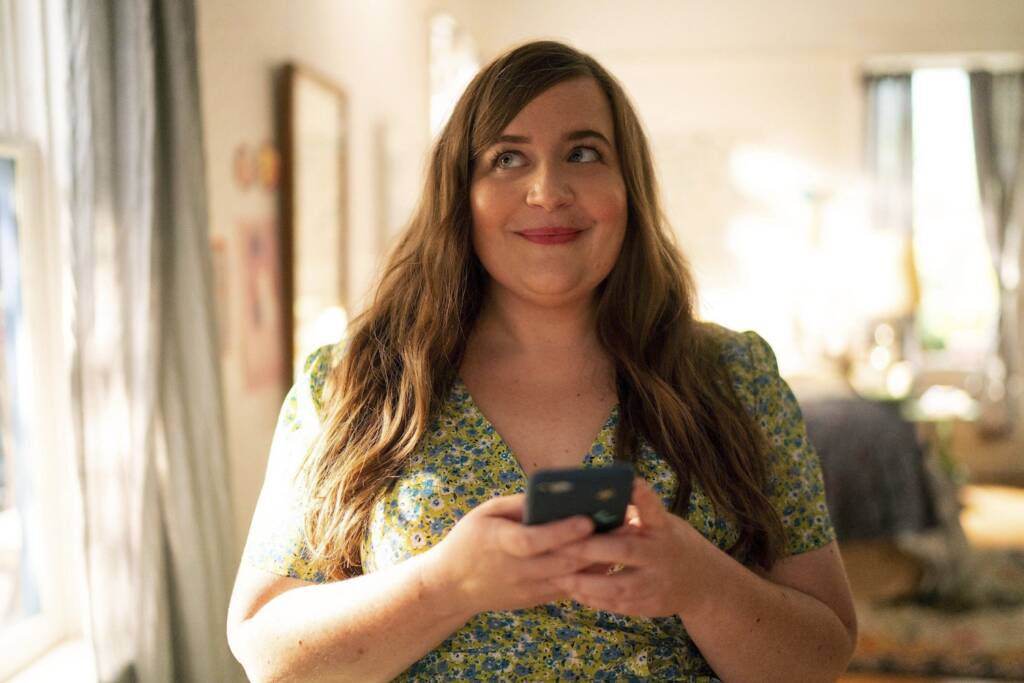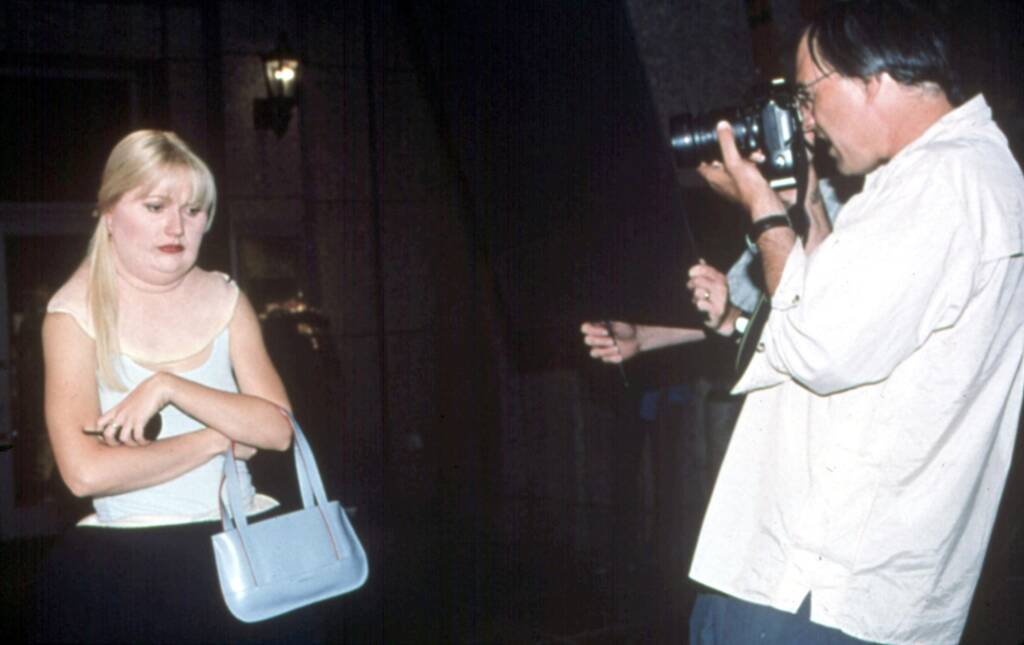Writing by Rebecca Shaw
Rebecca Shaw explores the intersections between queer and fat representation on screen, and the uneasy relationship between fatness and comedy.
When I was eleven and living in regional Queensland, Australia, if you had asked me if society would treat me worse because I was gay or fat, without hesitation I would’ve said gay. I rarely, if ever, saw gay people – saw myself – on screen. Growing up, I had to scour SBS late at night to catch a glimpse of a gay person (usually in a depressing situation) in foreign black-and-white films, and like a grizzled gay detective I searched mainstream TV and movies for clues and subtext that something fruity might be afoot.
While queer characters were hard to find, Dan and Roseanne Conner (John Goodman and Roseanne Barr) appeared nightly. The stars of Roseanne were fat, funny, confident and overtly sexual. In the two decades since, I’ve watched gay characters evolve from being tokens to protagonists, while representation for fat people crawled like an unusually slow snail. I could never have predicted that queer representation would become the norm and Roseanne would remain one of the few positive fat characters on TV, who are still all seemingly restricted to one area – comedy.
Around that time, when I realised I was gay, I was so terrified that I stayed closeted for ten years, convinced it was unacceptable and repulsive, that I’d be ostracised. What I didn’t know was that I should have been just as concerned about being fat.
You can’t closet fatness. It’s always on display, making you a moving target. The reactions permeate your life, from someone’s demeanour changing when they decide you don’t matter, to a stranger calling you a fat bitch and flicking a cigarette at you. As much thought as I put into remaining closeted, I put an equal amount of thought into my body and using that body to move through the world. Especially as an adult, I’ve been abused, harassed, ignored, discriminated against, mistreated by the medical system and rejected – all the things I was afraid of as an eleven-year-old.
Some of these things have happened because I’m queer as well, of course. But as a cis white queer woman, I’ve been pretty lucky to mostly protect myself. And as a cis white queer woman, I’ve gratefully witnessed society’s progression when it comes to queerness and queer representation. I’ve gone from being terrified that my high school classmates would suspect something to watching high school students on Netflix have carefree queer experiences. I’ve gone from only hearing about gayness in negative terms to watching Kristen Stewart in a gay Christmas rom-com. It’s amazing, and it’s also made me think about the progress that has been made regarding fatness.
By all accounts, queer people make up less than 10 per cent of the population, yet we’re now everywhere in popular culture. This is good, obviously. I want more and more, like a greedy little piglet. However, in 2017–18, it was estimated that two out of every three Australians are overweight.1 Think about how many fat women you encounter in real life.
Now name as many fat actors as you can think of.
What number did you get to? Melissa McCarthy, she was on your list. Amy Schumer, perhaps? Did Lena Dunham (who is maybe a size 14) get a mention? Rebel Wilson? Sorry, you have to remove her now that she’s no longer fat. I’m a fat, pop-culture loving lesbian and I can only come up with about seven. Film and TV would have you think there are about 100 fat women in the universe and that they’re all inherently funny. This exercise (no pun intended) shows how few fat women appear on screen, but it also shows that the first women who come to mind are all comedic actors.
It’s a complicated state of affairs. Undoubtedly part of the reason I’m funny is because I had to carefully negotiate social situations while closeted and fat. I had to disarm people with my personality and jokes, and the only positive attention I could garner was from being funny. During this time, when fat women were represented on screen, it was usually in a comedy, but fatness was almost always the butt of the joke. It was Monica from Friends (1994–2004), dancing uninhibitedly in her fat suit for laughs. It was Gwyneth Paltrow in Shallow Hal (2001), breaking seats wherever she went.
But comedy is also where fat women have most often forced their way into the driver’s seat. Melissa McCarthy is one of the biggest names in the business. Amy Schumer is iconic. Mindy Kaling can do whatever she wants. This hasn’t happened in the same way for fat women outside comedy. Comedy has been both an area of attack and a safe haven, the main place where we can see any progress at all.
Comedy allows for progress in more ways than just fatness, too. It questions what an acceptable body is, and what we allow women to do with their bodies. Neither of the stars of Broad City (2014–2019) are fat, but they push boundaries in a way that includes fatness. Through comedy, they push back against expectations for women on screen by being ‘unladylike’ and ‘unfeminine’. They’re loud and confident and hairy. They store weed in their vagina, or pee out a condom, or remove shit from a toilet that won’t flush. Their body positivity, although not specifically about fatness, still has an overall effect. In Kiki and Kitty (2017), Kiki (Nakkiah Lui) is a repressed lawyer who speaks to a personification of her vagina (Elaine Crombie), who guides her towards embracing her true self by carrying out her dreams of being an ice skater, even though she’s fat. We get a fat masc lesbian in Abby McEnany’s Work in Progress (2019–2021), which also explores fatphobia’s real-life impact on someone’s mental health. In the first episode, a passive-aggressive co-worker gives Abby a bag of almonds to encourage weight loss – the season follows Abby as she throws out one almond per day, with a plan to commit suicide if she is not happy by the final almond.
The TV adaptation of Lindy West’s book Shrill (2019–2021) was particularly significant. Aidy Bryant’s protagonist Annie is fat, yes, but the show speaks bluntly and directly about that fatness, portraying how it impacts her life in a way that I haven’t seen before. In one monologue, talking about her boss publishing an article on the ‘obesity crisis’, she says, ‘Cool man, very original point. You don’t think the whole world isn’t constantly telling me I’m a fat piece of shit who doesn’t try hard?’ There’s no tiptoeing around it, no double-speak. She considers how her fatness, and society’s treatment of her fatness, has affected her since childhood, how it has destroyed her self-esteem, and how that invades everything important, including how badly she’s willing to be treated, and how badly she’s willing to treat others. The third season shows something I’ve never seen but felt in my fat bones when Annie rejects a nice man because he’s also fat. I remembered shamefully that, when I was younger, I avoided making fat friends in the deranged, desperate hope that maybe people won’t notice you’re fat if it’s just you.
Annie’s best friend Fran (Lolly Adefope) is far further along in her journey than either Annie or I were. Yes, there are TWO fat women on ONE show! Besides that rarity, Fran is a fat, Black, queer woman who has been confident in her body (and queerness) long before Annie learns to appreciate her body, or let others appreciate it. Through flashbacks we see Fran’s college romance with another fat, Black, queer woman. During a pool party for fat people, Fran immediately vibes with another fat woman and we see her go after and get what she wants. In the third season, we see her build a relationship with ER Fightmaster’s Em: a tall, thin and stunning person, who Fran has no hang-ups about and great sex with. Fran’s just herself. She feels attractive; other people find her attractive. It’s as simple as that, and the simpleness is made all the starker by how Annie complicates things at every step.
Fran accepts herself much faster than Annie, and if it’s at all true to my experience it’s at least partly because of her queerness. It wasn’t really until I started making more queer friends with various body types, going to parties with beautiful, queer, fat people dressed in skimpy clothes, having sex with fat people and people with different bodies to mine, and letting them appreciate my body, that I truly began moving past those earlier hang-ups. The queerness and community portrayed on shows like Shrill allows us to live more easily outside of the stringent boundaries of what bodies are accepted, and what bodies are expected to do.
These are serious topics but comedy is still the way in and the main way to get these stories to screen. I’m certain that Shrill only exists because it’s a comedy, and because it stars Aidy Bryant, one of a handful of working comedic actors. I’m forever grateful to comedy for creating these spaces, but I want to see a fat romantic lead in a film that isn’t about a head injury, like Shallow Hal. I want it to be natural for someone to love a fat woman, not a wild anomaly. I want fat people to be represented in varied ways like queer people have been, because that has not only helped the queer people watching, it has helped society move forward as a whole.
I want fat representation to improve like queer representation has, so that any eleven-year-olds who are questioning themselves, perhaps hating themselves, can see a different way of life sooner, and across more genres and stories than just comedy.
Rebecca Shaw’s chapter Fat is from Goddess: Fierce Women on Film, the accompanying publication to ACMI’s exhibition Goddess: Power, Glamour, Rebellion which explores women’s representation on screen.
More info on the exhibition can be found here and the book can be purchased here.










